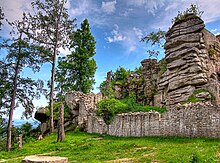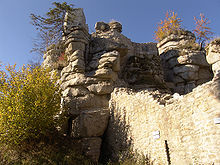Weißenstein ruins (Steinwald)
| Weissenstein ruins | ||
|---|---|---|
|
Weißenstein castle ruins from the north-west |
||
| Creation time : | probably 13th century | |
| Castle type : | Höhenburg, spur location | |
| Conservation status: | Ruin, remains of walls, parts of the keep | |
| Place: | Waldershof -Weißenstein | |
| Geographical location | 49 ° 54 '50 " N , 12 ° 4' 59" E | |
| Height: | 863.5 m above sea level NHN | |
|
|
||
The Weißenstein ruin stands at 863.5 m above sea level. NHN high Weißenstein in the stone forest between Waldershof and Erbendorf in the northern Upper Palatinate .
history

The name of the Steinwaldburg Weißenstein first appeared in a document on March 21, 1279 as "Wisstenstein". At that time a "Wolff de Wisstenstein" appeared as a document witness in a transfer of goods. Other witnesses were representatives of the Notthracht family . Before this time, the Wolffe will probably also have been the builders of the first small castle complex on the then important road from the Friedenfels area across the Steinwald to Hohenhard , although this cannot be documented . The facility at that time was called "Blochwerk", a castle with a tower, the upper floor of which was designed in half-timbered or block construction. Around 1290 Ludwig, Dietrich and Nicklas Wolff von Weißenstein were named as owners. Already in 1309 Albert Notthaft VI. , Descendants of an old ministerial family who had previously been wealthy in Bohemia, acquired part of the Weißenstein.
1333 was his son Albrecht Notthracht XI. Co-owner of the Weißenstein. When Ludwig the Bavarian bestowed the imperial and ducal fiefs on him, it was expressly emphasized that because of his father's support for Frederick the Beauties of Austria, who was defeated in the dispute over the throne , he should have no harm. The Weißenstein was probably badly affected in the armed conflicts of the throne dispute as well as in the war between King Ludwig the Bavarian and King John of Bohemia . But as early as July 25, 1339, the burgrave Johann II of Nuremberg, field captain of King Ludwig, allowed Albrecht Notthracht XI to “plow and improve the Weissenstein fortress as he wants”, but it had to be “ an open house “To be for the burgrave.
After Albrecht Notthracht XI. In 1341, when Gerhard dem Wolff von Thumsenreuth acquired the last third of the Weißenstein , he will have initiated the generous construction and expansion of Weißenstein Castle. At that time it may have received the extent as can be seen from the partially exposed or still buried foundation walls, a very remarkable structure for this place. In 1373 Albrecht Nothracht XII., The son of Albrecht Notthracht XI., Owned the Weißenstein. He founded the Weißensteiner line of the Notthracht family. Their descendants owned the Weißenstein until it died out in 1718. In the meantime, the Weißenstein lordship was sold to von Waldenfels , who were related by marriage to the needy, from 1552 to 1566 , but then bought back. Then her relatives from the Bodensteiner line followed as owners until 1882. Right from the start, the castle was not always owned by one person; it belonged to the family association. Every member of the Weissenstein Notthaft had a more or less large share in the castle ( Ganerbschaft ). In a castle peace treaty of 1464, the then owners Fritz, Gilg III. and Ulrich Noth manages the maintenance and use of the castle. At that time, a keeper was named as castle administrator and two gatekeepers. This shows that Weißenstein Castle was rarely used as the owner's apartment at that time. The emergency workers built their new seats in Friedenfels and Poppenreuth .
Weissenstein Castle was probably finally given up after 1560. The buildings fell into disrepair and buried part of the walls under their rubble. The tower also lost its structure and certainly part of its original height. This is proven by the many tower blocks found at the foot of the rocks. In 1882 the Notthracht lost their goods and with them the Weißenstein when they bought Bianca Eiserhart from a family of Silesian manufacturers. After her death in 1885, Gustav Siegle from Stuttgart acquired the property. In 1918 his daughter Dora and her husband Fritz von Gemmingen-Hornberg took over the property. In 1955, their son Wolf Dieter Freiherr von Gemmingen-Hornberg became his successor, and his son Eberhard Freiherr von Gemmingen-Hornberg has been the owner of the former Weissenstein estate in Friedenfels since 1973.
In 1995, as the built on a high rock cliff of the castle ruins barely keep danger of collapsing and two, about four feet high wall remains recognizable. Other wall sections were only recognizable in the form of wall-like elevations. The company Steinwaldia Pullenreuth e. V. restored the remaining parts of the building between 1996 and 2000 with considerable expenditure of time and money and ensured the preservation of the cultural and historical monument. In an information pavilion, the hiker receives information about the history of the Weißenstein and the renovation of the facilities. The Weißenstein castle ruins are an attraction for hikers, but also a backdrop for concerts, theater performances and other cultural events.
Keep
The approximately 7.5 m high keep now serves as a lookout tower. In the course of the renovation, the tower, preserved in the original masonry up to a height of around 5.5 m, was raised by 2 m with stone blocks found in the area. A four-part wooden staircase leads from the castle courtyard to the side to the entrance of the keep, which is about a third of the height of the south-eastern end wall. Inside you can reach the viewing platform made of maple wood via further wooden stairs.
Geotope
The massive rock towers made of partly bizarrely weathered granite wool sacks are designated as geotopes.
literature
- Eleonore Wintergerst: A late medieval clay wind instrument from the Weißenstein castle ruins in the Steinwald . In: "Contributions to archeology in the Upper Palatinate 3". 1999. ( Entry in the Bavarian State History Magazine Show )
- Silvia Codreanu-Windauer , Karl Schnieringer: The gate system of the Weißenstein castle ruins in the Steinwald . In: "Contributions to archeology in the Upper Palatinate 4". 2000. ( Entry in the Bavarian State History Magazine Show )
- Günter Moser, Bernhard Setzwein, Mathias Conrad: Upper Palatinate Castles - A journey to the witnesses of the past . Buch and Kustverlg Oberpfalz, Amberg 2004, ISBN 3-935719-25-6 , pp. 12-15.
- Harald Stark : The Notthracht family - looking for traces in Egerland, Bavaria and Swabia . Weißenstadt 2006, ISBN 3-926621-46-X .
- Ulrich Kinder: The fortifications in the Tirschenreuth district . From the series: Works on the Archeology of Southern Germany, Volume 28 . Publishing house Dr. Faustus, Büchenbach 2013, ISBN 978-3-933474-82-7 , pp. 133-139.
Web links
- Weißenstein castle ruins on burgseite.de
- Weißenstein Castle at www.notthracht.de
- Weissenstein castle ruins
Individual evidence
- ↑ Map services of the Federal Agency for Nature Conservation ( information )
- ↑ Weissenstein Castle Ruins - Restoration section on the Weissenstein Castle Ruins website
- ↑ Geotope: Weissenstein ruins WSW von Fuchsmühl (accessed on November 6, 2015)







